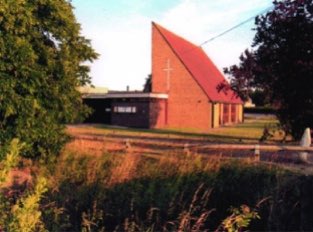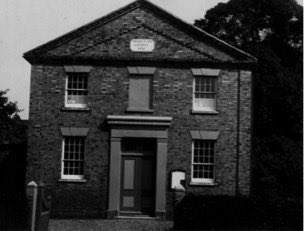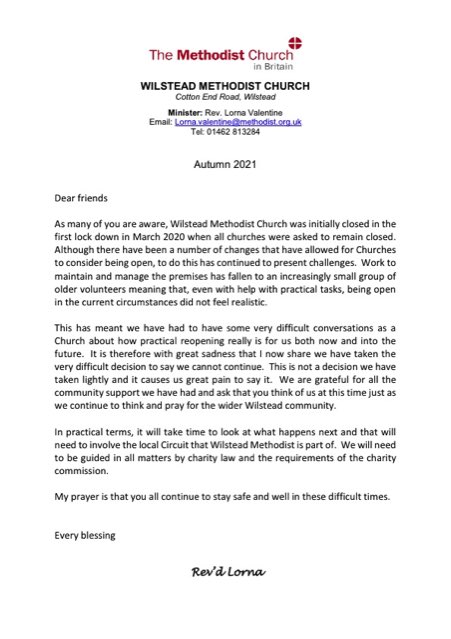

Wilstead Methodist Church
Cotton End Road
Wilstead
Wilstead Methodist Church – A Brief History
The first Methodist Chapel was situated in, of all places, Chapel Lane in Wilstead (or Wilshamstead – Wills Homestead – as it was formerly known).This was close to the home of a local farmer, William Armstrong, dating back to the 16th century. All that remains of this building now, is the memorial tablet from the wall of the chapel, which now takes pride of place in All Saints Church.
This carving reads:
'This tablet is erected to the memory of William Armstrong of Wilshamstead who was the means of introducing Methodism into this village and was a member and a class leader for nearly 40 years. The first Chapel on the site (in Chapel Lane) was erected under his auspices AD 1808 and in 1841 he enjoyed the hallowed pleasure of laying the foundation stone of this 'Latter House'. After a life of consistent piety, he died in the full triumph of faith on the 23rd of July 1945, aged 76 years'.
This represents the earliest written record of Wesleyan Methodism in Wilstead.
At this stage the Chapel was within the Biggleswade Circuit and apparently it wasn't unusual for the preachers to walk 10 mils to conduct a Sunday Service.
Whilst there's little documentary evidence regarding the Chapel itself, we have lots of information about the associated Sunday School. Teachers were apparently very strict with the children, who had to pay for the privilege!
In 1949 the Chapel's Organ – a Trustam hand operated pipe organ – proved to be beyond repair, so a replacement was sourced from a Church in Gorton, a suburb of Manchester, at a cost of £150. This has to be dismantled, transported and reinstated. * members and friends undertook this task, under the Ministerial guidance of Rev. Allen Harding.
Services continued in the Chapel into the 1960's when, unfortunately, it was identified that the foundations of the building would require extensive repairs to remain safe. Happily at this point, a member of the Trustees suggested a new church if a site could be found. This was agreed and an established villager, member and trustee, Mr Cyril Taylor, gifted a fifth of an acre in the heart of the village, where the present Church now stands.
A building of contemporary design had its foundation stone laid in the early months of 1967 and opened on the 25th of November that same year. The organ was built specially, with some of the pipes coming from the old Chapel organ. The then organist, Mr Colin Cooper, had begun playing at the age of 15 in 1949. He continued right up to his passing in 1996.
The original cost of the Church was £22,000 and this sum meant that the Church Hall wasn't added until later, under the project management of Mr David Gurnhill. The Hall was dedicated in March 1972.
The Church has a prominent position in our growing village and we find that the Church Hall was constantly in use for community groups such as Scouts, Cubs and Brownies, Mothers and Toddlers, even a Martial Arts group!
The Church also provided a real service to the community, by providing a home for an Ampthill Doctors Practice, where a full Surgery Service is proved several each week, for those who are less able to travel.
The Church has been home to various Circuit Events, such as the Youth Club and Eisteddfod, which ran for many years with participants aged between 5 and 18, from Churches right across the Circuit. Classes were varied, featuring Music, Bible Reading and Crafts galore. Each class was carefully judged and youngsters were encouraged at every stage. The whole event was drawn together with a 'Winners Concert' staged two weeks later.
Alas the worshipping congregation is now quite small, but as well as Sunday Worship, we attend a weekly 'House Group'. These meetings take place in member's homes and are attended both by our congregation and others from the village. We also maintain a small Singing Group (The Wilstead Singers) who are often invited to provide a song or two at other Church Events throughout the year.
